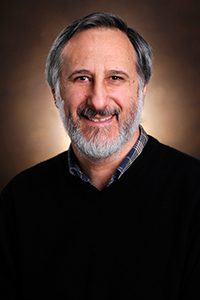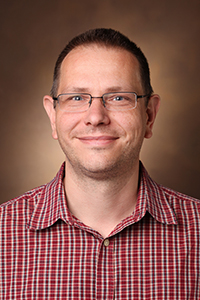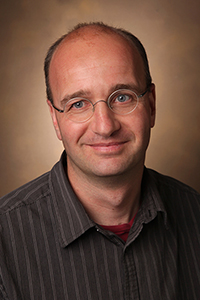2019 Faculty Participants
Students will work in the lab for one or both mentors on the research team. For more information about faculty research interests, visit their websites via the links below.
Lauren Buchanan (Chemistry) and Lars Plate (Chemistry)Misfolded proteins are gaining interest in both the scientific and medical fields due to their propensity for forming cytotoxic amyloids, which are associated with a number of diseases such as type II diabetes, Alzheimer’s, Huntington’s, and Parkinson’s. On the other hand functional amyloids can be seen in human hormone storage in secretory granules. Amyloid fibrils, which can be functional or cytotoxic, are peptide or protein aggregates that organize into long, unbranched fibrils with a cross β-sheet structure. The structural mechanism of how proteins can self-assemble is currently unknown. Our research is focused on functional amyloids as a model for the aggregation process for cytotoxic amyloids. Specifically, two human hormones, cholecystokinin (CCK) and gastrin, that share the C-terminal sequence: WMDF. This is the minimal sequence needed for biological activity and has demonstrated the ability to convert between amyloid and crystalline structures by varying pH levels. In the body CCK and gastrin exist as varying short peptide fragments of the full length hormone. The short fragments are easily synthesized; thus, they are excellent starting points for studying amyloid reversibility. 2D infrared spectroscopy, using ultrafast lasers, has the temporal resolution necessary to observe real time structural changes, and when implemented with isotope-labeled samples can monitor protein structure with single-residue resolution. This can be used to determine a precise aggregation mechanism. Understanding the structural mechanistic properties of functional amyloids can provide insight on disease-linked amyloids and future therapeutics or reversal of diseases associated with amyloid fibrils. |
|

|
Steven Townsend (Chemistry)Multi-drug resistant (MDR) Gram-negative bacterial infections are an ongoing challenge to public health. Indeed, 4 of the 6 “ESKAPE” pathogens – recently highlighted as responsible for the majority of hospital acquired infections – are Gram-negative pathogens. Although it is clear that novel antibiotics for Gram-negative infections are desperately needed, there has been minimal progress in this regard, and it has been over five decades since a new class of drugs have been introduced for Gram-negative bacteria. The development of new antibiotics to treat these pathogens is complicated by the fact that Gram-negative bacteria have an impenetrable membrane that confers intrinsic resistance to antimicrobial agents. The broad objective of this program is to study glycoconjugates to combat Gram-negative pathogens. |
 |
|
Borden Lacy (Pathology, Microbiology, and Immunology)Defining the structures of proteins that regulate microbial functions can be the first step in understanding how these proteins contribute to bacterial survival or pathogenesis. In this project, students will take part in a discovery-based experimental pipeline for structural characterization of novel bacterial protein targets, with opportunities to collaborate directly with microbiology researchers in a multi-disciplinary environment. Researcher Skills and Interests: This project is best suited for those students who have taken a biochemistry course and who have an interest in proteins and protein structure. Students will learn molecular biology, biochemistry, and structural biology techniques including PCR-based mutagenesis, protein purification, biophysical and functional characterization assays, and protein crystallization. |

|
|
Walter J. Chazin (Biochemistry) and Eric P. Skaar(Pathology, Microbiology, and Immunology)In tissues infected by pathogens such as Staphylococcus aureus, the host responds by depriving the invading organism of essential nutrients that are critical for growth and survival, mechanisms termed nutritional immunity. For example, calprotectin (CP) is heterodimeric protein that forms an integral part of the innate immune response to invading pathogens by sequestering away essential transition metals including zinc and manganese. This project involves defining the functional basis for CP’s activity through the design, production and evaluation of calprotectin mutants that alter its capacity for binding essential metals and ability to bind to cell surface receptors that mediate the inflammation associated with the immune response. This project is best suited to students who have taken a biochemistry and/or microbiology course and who may have knowledge of site-directed mutagenesis by PCR and protein purification. Students should possess an interest in learning state of the art multi-disciplinary research and will use a combination approaches ranging from bacterial growth suppression assays to high-resolution structural analysis. |

|

|
Vsevolod Gurevich (Pharmacology, Opthalmology & Visual Sciences)Mammals have two non-visual arrestins, both of which are expressed in every cell in the body, bind hundreds of different G protein-coupled receptors (GPCRs) and dozens of non-receptor partners. Arrestins scaffold several MAPK signaling cascades, including those that lead to activation of JNK family kinases that have anti-proliferative, often pro-apoptotic effects, and leading to the activation of ERK1/2 with opposite biological effect. Based on our structure-function studies, we designed signaling-biased arrestins that bind tightly unphosphorylated GPCRs, as well as enhance or suppress signaling via JNK and ERK. One of the novel tools we developed is a mini-scaffold, a short arrestin-3-derived peptide that binds all kinases in the ASK1-MKK4/7-JNK1/2/3 cascades and facilitates JNK activation in intact cells. The effects of several smaller peptides depend on cell type, with striking difference between COS7 cells and neuronal cell lines. The project is a continuation of this work. It will involve mostly the work with cultured cells and construction of clones to express new peptides in mammalian cells and in-cell JNK activation (by Western blotting). The ability to regulate cell death and survival via MAPK activity has therapeutic potential in numerous disorders, from cancer, where excessive proliferation underlies the pathology, to neurodegenerative diseases, such as Alzheimer’s and Parkinson’s, where excessive cell death is at the root of the problem. |

|
|
Jens Meiler (Chemistry, Pharmacology, Biomedical Informatics)Research projects in the Meiler laboratory fuse computational and experimental efforts to investigate proteins, the fundamental molecules of biology, and their interactions with small molecule substrates, therapeutics, or probes. We develop computational methods with three major ambitions in mind. A) To enable protein structure elucidation of membrane proteins the primary target of most therapeutics and large macromolecular complexes such as viruses; B) Design proteins with novel structure and/or function to explore novel approaches to protein therapeutics and deepen our understanding of protein folding pathways. C) Understand the relation between chemical structure and biological activity quantitatively in order to design more efficient and more specific drugs. REU project sin all three areas are available. Current research applications focus on new approaches to a) drug and probe development for neurodegenerative disorders and diseases including Schizophrenia, Alzheimer's, and Parkinson's, b) understanding the structural determinants of antidepressant binding to neurotransmitter transporters, c) cardiac arrhythmia as caused by the complex interplay of potassium channel regulation and drug interactions, d) multidrug resistance in cancer and bacterial cells related to multidrug transporter proteins, and e) structural basis of viral infections and antibody activity. |

|
|
F. Peter Guengerich (Biochemistry)Projects in this laboratory involved cytochrome P450 (P450) enzymes, the major catalysts involved in the metabolism of drugs, steroids, fat-soluble vitamins, carcinogens, and industrial chemicals. A major goal in the relationship of structures to function. One project involves genetic variants of P450 21A2, which cause congenital adrenal hyperplasia. We are the only laboratory that has solved X-ray crystal structures of this enzyme. More than 100 clinical variants have been reported, and we wish to crystallize some of these to define the structural changes responsible for loss of activity. Other projects involve searches for catalytic functions of other human P450 enzymes, which are unknown in these “orphans.” We are using a battery of methods, including liquid chromatography-mass spectrometry, metabolomic analysis, and other approaches. Another area of research involves pre-steady-state kinetic measurements on individual reaction steps in P450 biotransformations. |
 |
|
Claus Schneider (Pharmacology)Epoxides of the polyunsaturated w-6 fatty acid, arachidonic acid (C20:4w6) have desirable functions in human physiology. Most notable are their roles as protective lipid mediators in cardiovascular disease events like myocardial infarction or as endogenous analgesic mediators in inflammatory and neuropathic pain. Epoxidation of arachidonic acid is catalyzed by various cytochrome P450 enzymes and results in formation of isomeric epoxyeicosatrienoic acids (EETs), namely 5,6-, 8,9-, 11,12-, and 14,15-EET. EETs are metabolized by the enzyme soluble epoxide hydrolase (sEH) forming biologically inactive dihydroxy-eicosatrienoic acids (DiHETs). Thus, inhibition of sEH is desirable in order to enhance the bioactivity of endogenous EETs, and a number of compounds have been developed as drugs for the inhibition of sEH. Some advanced sEH inhibitors are currently tested in clinical trials in humans. There is little information on natural products as inhibitors of sEH. The identification of natural compounds that inhibit sEH, e.g., in dietary supplements, could provide patients with “natural” alternatives for the treatment of chronic pain with lower risk for adverse side effects. The protoberberine alkaloid dehydrocorybulbine (DHCB) was identified as a potential novel analgesic in a screening effort that tested 500 HPLC fractions obtained from 10 different Chinese medicines for the inhibition of m-opioid and dopamine receptors. The Schneider lab reasoned that DHCB may also inhibit sEH, and preliminary studies showed potent inhibition of the hydrolysis of 11,12-EET by recombinant human sEH in vitro . This suggests a novel mechanism by which DHCB may exert analgesic and cardioprotective effects. DHCB and some of its naturally occurring isomers are currently isolated in the Schneider lab from Corydalis yanhusuoextracts that are commercially available as dietary supplements. DHCB is a minor component of the extract making the chromatographic isolation tedious and chemical synthesis a desirable alternative. DHCB will be used to elucidate the mechanism of inhibition of sEH and, if sufficient amounts are available, to quantify the effects on sEH activity and levels of EETs in vivo upon oral administration to mice. Positive results will pave the way towards studies on therapeutic effects of DHCB in animals and possibly in humans. |
 |

